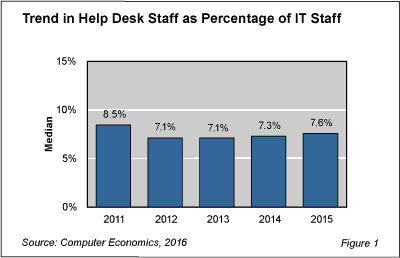IT organizations are slowly returning their help desk operations to full strength, as this function continues to make gains as a percentage of the IT staff.
Over the past four years, help desk staffing levels have risen slightly, from 7.1% in 2012 to 7.6% in 2015, as shown in Figure 1 from our study, Help Desk Staffing Ratios.

At the start of the recovery, we see that the help desk staff did jump to a high of 8.5%, but that was an anomaly. It appears that early in the recovery, IT organizations were quick to bring the help desk staff back to full strength and, perhaps, were slower to begin hiring in other areas. The annual fluctuation in help desk staffing reflects relative changes in the staffing mix, as such, other positions could be growing or shrinking, making the help desk staff appear smaller or larger as a percentage of the total.
In our study, we define help desk staff as personnel who provide first-contact support to end users, typically by phone, email, or chat. The category does not include desktop support personnel or subject-area experts such as network management, systems management, or application programmers who may respond to escalations from the help desk. Nor does the help desk staff headcount include managers or trainers. They are in separate categories.
Help desk staff generally resolve 50% to 80% of incidents at Level 1 on a first-call basis. They may escalate some Level 2 issues to personnel within the help desk organization, while other Level 2 and Level 3 support issues require escalation to technical support outside the group or even outside the organization to vendors or third-party service providers.
Because the help desk comprises a sizable portion of the IT staff, it can be a target for outsourcing and efficiency gains through improved processes and automation tools. Yet as organizations absorb more applications and technology, including smartphones and other mobile devices, they also can find a need to expand the help desk function. Moreover, as companies embrace IT service management, the service desk takes on added responsibilities for ensuring users remain happy and productive.
As such, help desk staffing levels require ongoing assessment. The full study provides metrics for benchmarking help desk staffing levels in the current environment. We look at the trend in help desk staffing over a five-year period and provide two benchmarks by organization size and sector: help desk staff as a percentage of the IT staff and users per help desk staff member. Because companies organize the end-user support function in different ways, we also provide benchmarks for a combined help desk and desktop support staff. We conclude with recommendations on optimizing help desk staffing levels.
This Research Byte is a brief overview of our report on this subject, Help Desk Staffing Ratios. The full report is available at no charge for Computer Economics clients, or it may be purchased by non-clients directly from our website (click for pricing).
Do you also need staffing ratios for other IT job functions? Consider this collection of all of our staffing ratio reports, which bundles them all into a single report at a significant discount: IT Staffing Ratios–Special Report Bundle.

